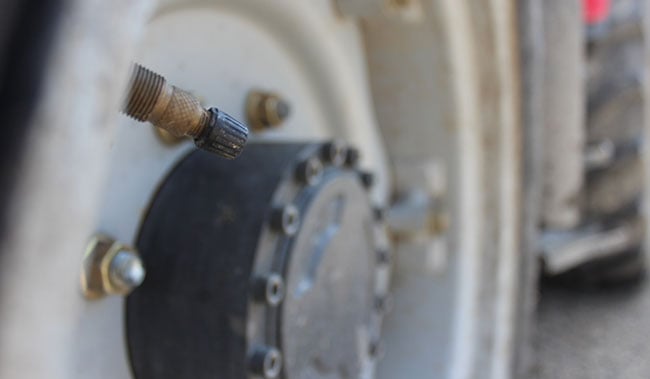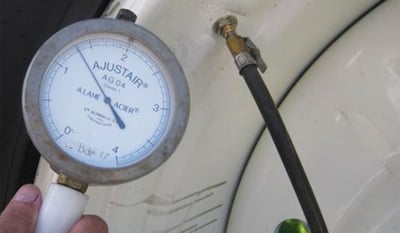Before you kick off a long day on the farm, we strongly recommend you check the pressure of your tractor tyres.
This quick check is often ignored due to a lack of time, but it can have a real impact on your work.
 Perhaps even more so than with other equipment, it is crucial you adjust the pressure of your agricultural tyres depending on their use. This will enable you to maximise your productivity and avoid damaging your fields and tyres, while at the same time increasing their life span.
Perhaps even more so than with other equipment, it is crucial you adjust the pressure of your agricultural tyres depending on their use. This will enable you to maximise your productivity and avoid damaging your fields and tyres, while at the same time increasing their life span.
The main risk of over-inflated tyres has to do with soil compaction. Regardless of the load being pulled, the pressure your tyres exert on the soil is similar to the pressure inside the tyre itself. Excessive compaction of the soil will impede root development and water infiltration, resulting in lower yields per hectare.
Over-inflation will also lead to rut formation in wet conditions, which means more work for you to restore the field.
Although reducing the pressure helps preserve the soil, if the pressure is too low the tyre's structure will degrade prematurely.

How to know the right pressure?
With a telescopic loader, fork or other equipment designed to bear frontal loads, the pressure must be adapted to the front axle over the rear axle depending on the weight of the load.
If a tool is coupled behind the tractor and hoisted by the lift arm, the load transfer is heavier than the weight of the tool on the two rear wheels. It is therefore vital to adapt the pressure based on the inflation range set by the manufacturer, considering the supported mass and tractor speed.
If you're using twin wheels, the pressure must be identical in each tyre. The pressure will be greater with narrow wheels (between 3 and 4.5 bar). A tractor with a very heavy tool might still only exert a low pressure on the soil if it's also equipped with low-pressure tyres. This goes to show that tyre pressure plays a much bigger role in soil preservation than the load being pulled; the same tractor can compact the soil much more with a light tool than a heavy one, depending on the tyre pressure.
For greater flexibility, you can also experiment with levers other than strict pressure regulation.
Mounting wide tyres on tractors and harvesters will also reduce the pressure, provided the spacing between rows allows for it. This will distribute the load across a larger surface area, and thus reduce the pressure exerted on the soil.
Most big brands now offer websites or mobile apps that you can use to quickly calculate your optimal pressure.
This will vary depending on the type of vehicle (tractor, combine harvester, sprayer, grape harvester, or tanker and trailer), axle load, front load, rear load and maximum speed.
If you'd like an example, you can download the easy-to-use Tyre Pressure app by Bridgestone Firestone here:
To learn more and boost your farm's profits, Bridgestone-Agriculture is offering you a free, detailed eBook that explains the essential role your agricultural tyres play in your productivity.
The most people who have read this article have also read the following articles, which are listed below in order of popularity:
This information is intended only to make you aware of the technical and functional aspects of agricultural tires and their use. It does not allow you to make a judgment or a definitive conclusion on a given problem. Only your agricultural tire expert is able to make a technical assessment and take a final decision, case by case.

BRIDGESTONE EUROPE NV/SA
AG Department
Leonardo Da Vincilaan 1
1930 Zaventem | Belgium
Our regional office:
Athena Drive, Tachbrook Park
Warwick CV34 6UX
United Kingdom